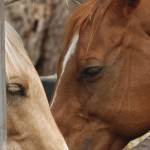Horse Feed Processing: Pelleted and Extruded Feeds

Horse feeds come in many different forms, each with their own advantages and disadvantages. While pelleted and textured feeds are well-known staples in the feed room, extruded feeds are gaining popularity for horses, although they have long been popular with owners of other pets, such as dogs and cats. So, what’s the difference between feed forms?
Pelleted feeds are common in commercial feed lines. Every bite of a pelleted feed is uniform, due to the thorough mixing of ingredients in the manufacturing process. Pellets have high nutrient availability and digestibility. However, horses tend to consume pellets quickly, which could be problematic for those that bolt feed. Further, pellets make it hard to disguise supplements, which can easily be sorted and left at the bottom of the feed bucket.
Extrusion is similar to pressure cooking. Ingredients are ground and conditioned with steam, then cooked for a short period of time under high temperature and pressure. The mixture is then forced through a die, which determines the size and shape of the final product. The extrusion process helps to break down the structures of starches and proteins, resulting in a “gelatinization” of starch and unfolding of proteins, helping to improve digestion in the small intestine, lessening the likelihood that starch reaches the hindgut.
Each bite of extruded feed is uniform, like a pellet, but extruded feed is softer and easier to chew. Horses also tend to consume extruded feeds slower than a comparable pellet. Extruded feeds typically contain little dust, making it a good option for horses with respiratory concerns. In addition, because of the high cooking temperature, extruded feeds tend to have longer shelf lives.
Extruded feeds can contain higher amounts of fat compared to a pelleted feeds, as too much fat will cause a pellet to fall apart. Higher fat means higher calories, which is a benefit for many classes of horses, including hard keepers and performance horses with elevated energy requirements. Horses who are not used to extruded feeds may take a few days to become familiarized with the lighter, airier texture.
Textured feeds, also known as sweet feeds, usually have high palatability, often attributed to higher molasses content compared to a pellet. High marks in palatability can be beneficial for picky eaters. Textured feeds are often easier to top-dress powdered supplements or medication, as they adhere easily to the sticky molasses. Grains, such as oats and corn, are often visible. Because textured feeds may have a combination of pellets, grains, or other ingredients, horses may be able to sort out the pieces they don’t like, potentially missing out on some nutrients or energy.
All of the feeds forms (pelleted, extruded, textured) can be soaked for ease of consumption and extra water intake. Extruded feeds tend to soak the fastest and fall apart the easiest, which is advantageous for horses with poor dentition. Pellets and textured feeds may require slightly longer soaking times, depending on the product.
All feeds forms can deliver essential nutrients in a palatable way. The right feed for a horse depends on his individual needs, including workload, body condition, and dental state.








